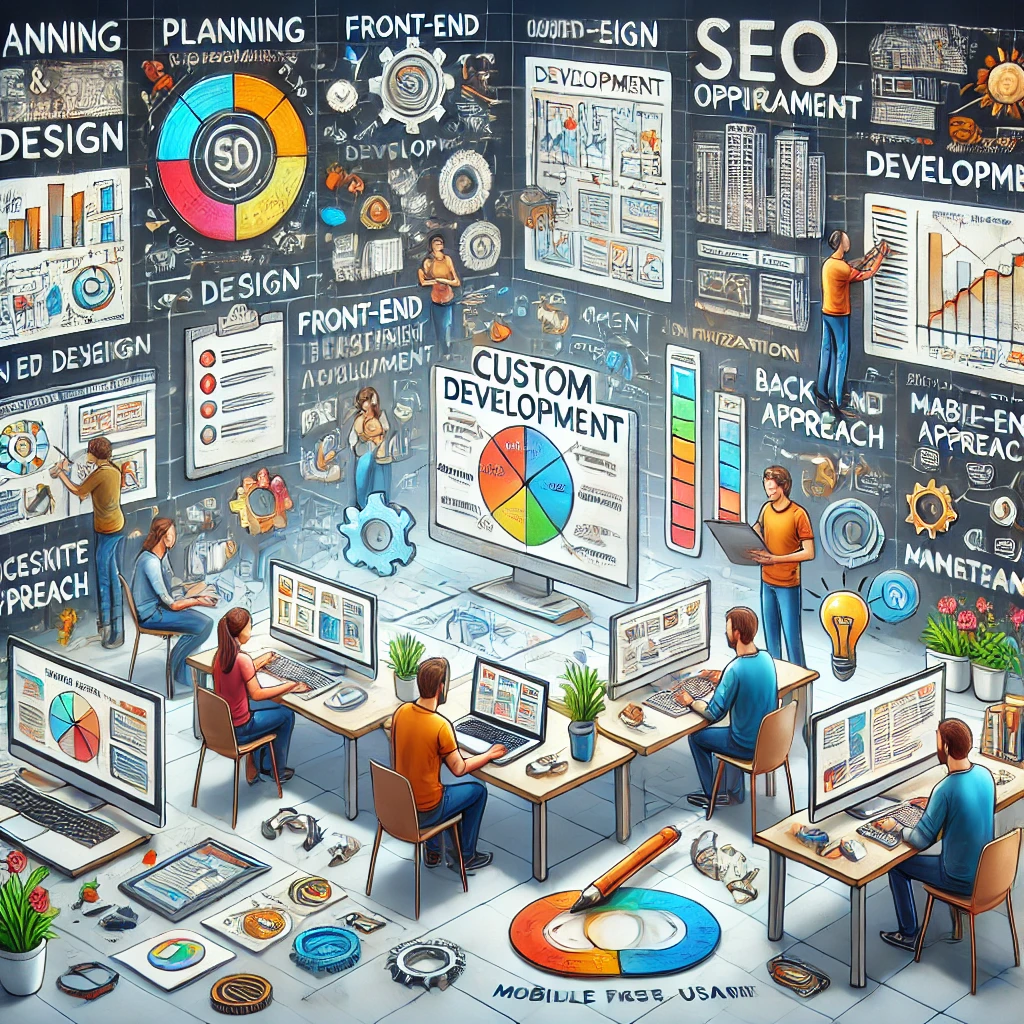PUBLISHED ON: December 17, 2024

Let's Talk
With over 3.5 billion internet users worldwide, businesses now have the perfect opportunity to grow their brand awareness, increase online reach, and connect with their target audience. But with so much noise in the digital space, how can your business stand out and convert followers into loyal customers?
The answer lies in a powerful strategy: Content Marketing.
In this guide, we’ll explore what content marketing is, its importance, and how you can leverage content formats like blogs, videos, and infographics to dominate your industry and drive real results. A well-defined content strategy will serve as a roadmap to guide the creation, publication, and governance of valuable content.
What is Content Marketing?
Content marketing is the process of creating and sharing valuable, relevant, and engaging content—such as blogs, images, videos, and infographics—to inform and educate your target audience. A content audit plays a crucial role in assessing existing content to determine its effectiveness in meeting business goals and to inform future content strategies. Unlike traditional advertising, content marketing focuses on: • Educating your audience about your products or services. • Establishing your business as an industry authority. • Building trust and credibility to drive conversions and customer loyalty.Definition of Content Marketing
Content marketing is a strategic marketing approach focused on creating and distributing valuable, relevant, and consistent content to attract and retain a clearly defined audience. Unlike traditional advertising, which often interrupts the audience with sales pitches, content marketing aims to provide meaningful information that educates, entertains, and engages. The ultimate goal is to drive profitable customer action by building trust, establishing thought leadership, and creating a loyal community around a brand. By consistently delivering high-quality content, businesses can position themselves as industry leaders and foster long-term relationships with their audience.Importance of Content Marketing
In today’s digital landscape, content marketing is essential for businesses to achieve their marketing goals and connect with their target audience. A well-planned content marketing strategy can help businesses increase brand awareness, generate leads, and drive sales. By creating high-quality, relevant, and valuable content, businesses can establish themselves as thought leaders in their industry, build trust with their audience, and drive long-term relationships and customer loyalty. Content marketing also supports other marketing strategies by enhancing SEO efforts, boosting social media engagement, and driving organic traffic to your website. Ultimately, content marketing is a powerful tool for building brand awareness and achieving sustainable business growth.Example of Effective Content Marketing
Instead of directly advertising a liposuction service, a clinic could: • Share an infographic highlighting the benefits of liposuction. • Publish a video explaining the latest technology and its advantages over other methods. The key is to deliver valuable, actionable information that answers the questions and concerns of your audience by creating content tailored to their interests and needs.Why Content Marketing Works
1. Builds Trust with Informed Customers
According to Nielsen, 63% of buyers perform online research before making a purchase. A study by MineWhat.com further highlights that 81% of shoppers look for product information online before buying. By providing valuable content, you position your business as the trusted choice in your industry. This builds confidence and increases the likelihood that customers will choose you over competitors. The content creation process, which includes steps from idea generation to publication, plays a crucial role in building this trust by ensuring that the content is well-researched, relevant, and engaging.2.2 2. Aligns with Consumer Behavior and Target Audience
Today’s consumers are looking for solutions—not sales pitches. Content marketing allows you to meet this need by offering relevant, high-quality content that guides buyers toward making smart decisions. A content management system (CMS) is crucial for managing and delivering content that aligns with consumer behavior, ensuring that the right content reaches the right audience efficiently.2.3 3. Boosts Online Visibility, Organic Traffic, and Engagement
With Google prioritizing high-quality content in search engine results, content marketing also helps improve your SEO rankings. Plus, formats like infographics and videos are highly shareable, amplifying your brand exposure across social media channels.Understanding Your Target Audience
Understanding your target audience is crucial to creating effective content marketing strategies. By knowing who your audience is, what problems they face, and what makes you unique, you can create content that resonates with them and addresses their needs. This involves conducting thorough market research to gather insights into your audience’s demographics, interests, and behaviors. By leveraging market research tools, you can gain a deeper understanding of your audience and tailor your content to meet their specific needs and preferences. This targeted approach ensures that your content marketing efforts are more effective and impactful.Who Will Be Reading Your Content?
Your target audience is the group of people who will be reading, watching, or engaging with your content. They may be potential customers, existing customers, or influencers in your industry. To create effective content, you need to understand their demographics, interests, pain points, and content preferences. This involves creating detailed audience personas that represent your ideal customers. By understanding who your audience is, you can create content that speaks directly to their needs and interests, making it more likely to engage and convert them.What Problem Will You Be Solving for Your Audience?
Your content should solve a problem or address a need for your target audience. By understanding their pain points and challenges, you can create content that provides value, educates, and entertains them. This will help you build trust and establish your brand as a thought leader in your industry. Whether it’s through blog posts, videos, or infographics, your content should offer solutions and insights that help your audience overcome their challenges. This problem-solving approach not only enhances your content’s relevance but also strengthens your relationship with your audience.What Makes You Unique?
Your unique value proposition (UVP) is what sets you apart from your competitors and makes your content unique. By understanding your UVP, you can create content that showcases your brand’s personality, values, and mission. This will help you differentiate your brand and attract a loyal audience. Highlighting what makes you unique in your content can include sharing your brand story, demonstrating your expertise, and showcasing your unique approach to solving problems. By consistently communicating your UVP, you can build a strong brand identity and foster a loyal community around your brand.Top Content Marketing Formats to Leverage
1. Infographics: Informative and Visually Appealing
Humans process visual content 60,000 times faster than text. Articles with images receive 94% more views, and 67% of consumers say visuals influence their buying decisions more than product information. Benefits of Infographics: • Simplify complex information into engaging visuals. • Increase shareability across social media platforms. • Attract and retain viewer interest. Tip: Use infographics to share industry stats, comparisons, or how-to guides in an artistic, organized format.3.2 2. Videos: Engaging and High-Impact Video Marketing
Videos have become a dominant force in content marketing: • Facebook logs 8 billion video views daily. • 4x more consumers prefer watching videos over reading about a product. • 1 in 4 customers lose interest in a brand that lacks video content. Benefits of Videos: • Showcase products, services, and innovations visually. • Build emotional connections with viewers. • Drive conversions through powerful storytelling. Tip: Share video tutorials, product demos, or customer testimonials to connect with your audience on a deeper level.3. Blogs: Informative and SEO-Friendly
While videos and images are highly engaging, blogs remain critical for delivering detailed, research-intensive content that is favored by search engines. According to Orbit Media: • The average blog post length has increased to 1,000 words for better engagement. • Bloggers who include multiple images and videos receive stronger audience responses. Benefits of Blogs: • Improve SEO with keyword-optimized, in-depth content that aligns with search engines. • Provide solutions to customer problems through long-form articles. • Build authority by sharing industry expertise. Tip: Focus on delivering valuable insights through “how-to” guides, product comparisons, and industry trends.Why Content Marketing Drives Results
Content marketing works because it integrates seamlessly with SEO and social media. By creating shareable, high-quality content, you: • Increase brand exposure through social media posts and social media shares. • Drive organic traffic to your website. • Position yourself as the go-to authority in your industry.Ready to Elevate Your Brand with Content Marketing?
At United SEO (USEO), we specialize in crafting results-driven content marketing strategies that grow your online influence and drive measurable success. From visually captivating infographics and high-impact videos to SEO-friendly blogs, we create content that resonates with your audience.What We Offer:
• Custom content creation tailored to your brand. • Effective SEO strategies to boost visibility. • Amplified exposure through social media content. Contact Delemon Technology today 📧 Email: info@delemontechnology.comReferences
No references available for this blog.




